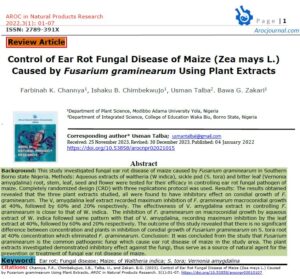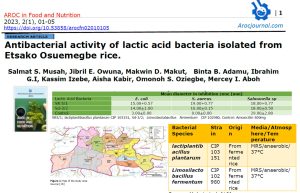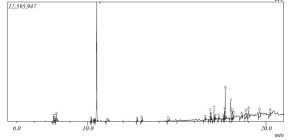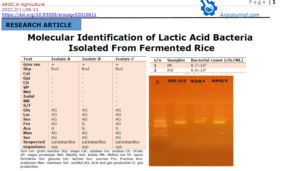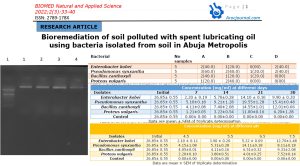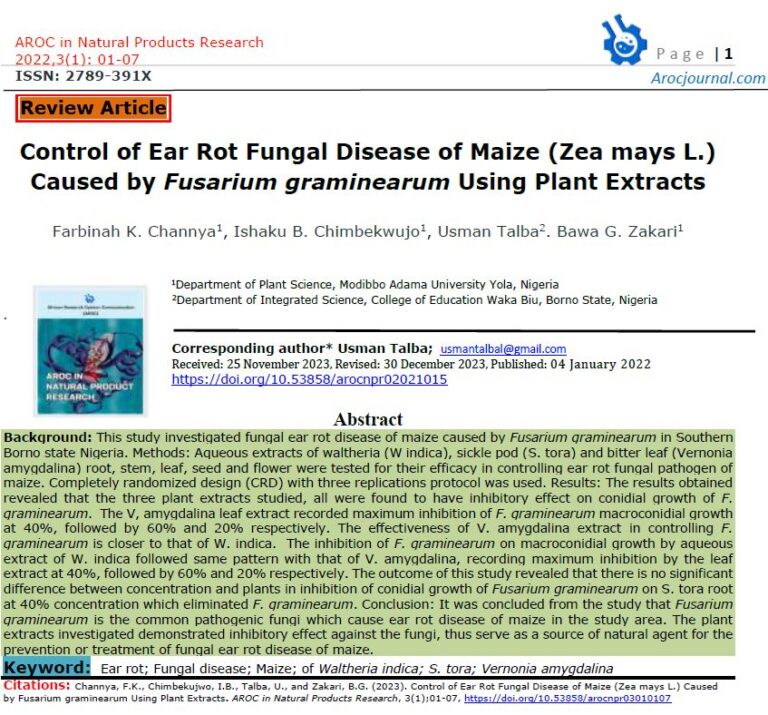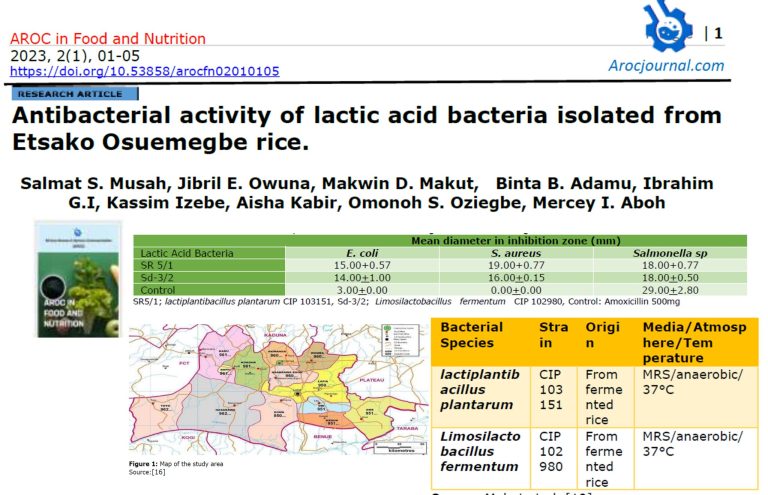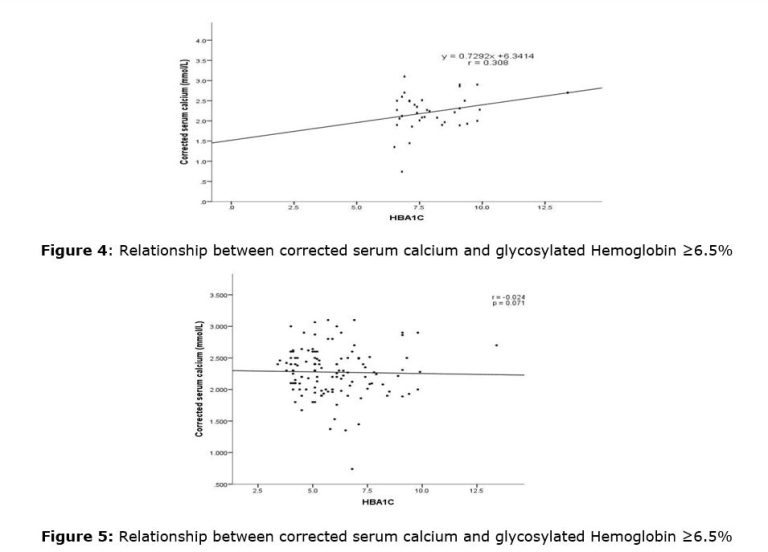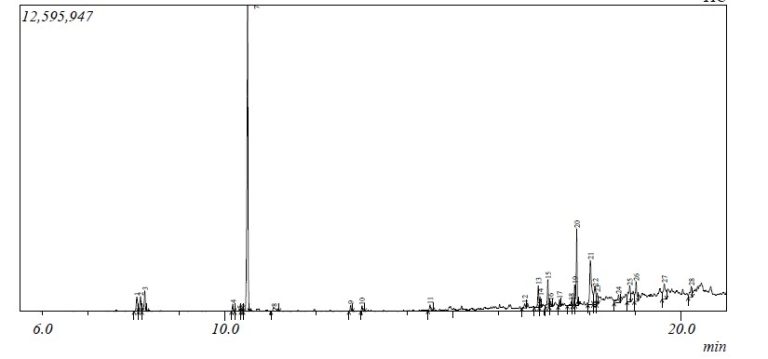1.0 Introductions
Mankind has always faced one challenge or the other in the course of his existence. A health challenge is one of the factors contributing to the high rate of death in Nigeria [1]. Covid-19 virus infection is presently the biggest health challenge in the world [2]. Since the first COVID-19 case was reported in Africa in mid-February 2020, the pace of the outbreak has accelerated, taking 98 days to reach the first 100 000 cases and only 19 days to rise to 200 000 cases. As of 24 September 2021, more than 321 million cases and more than 4 million deaths have been reported globally (WHO, 2020) [3].
Countries with the most prevalence cases included the USA, India Brazil, United Kingdom, France, Turkey, Iran and Argentina (Figure 1) [3]. In Africa, there are 8 180 555 cases; the five countries reporting most cases are South Africa (2 882 630), Morocco (919 681), Tunisia (700 807), Ethiopia (332 961) and Libya (332 026) [3, 4].
Good nutrition is one of the keys to disease prevention, treatment, management, and healthy life [5]. Access to a sustainable and healthy diet is a key requirement across the life course and across the globe. The relationship between food, nutrition and health, however, is complex, dynamic, and multi-faceted and highly affected by biological as well as environmental, socioeconomic, cultural and behavioural factors [6]. However, a high level of poverty which has a defined effect on nutritional status has been linked to the endemicity of infectious diseases in Sub-Sahara African [7]. Malnutrition has a negative effect on the body’s defence mechanism; the lack of certain essential nutrients which help the body to boost its immune system can make it susceptible to infectious diseases [8]. Effective nutrition on the other hand is an act of taking in diet, which contains nutritional components in the right proportion Effective nutrition, has a way of boosting the body’s defence against infection because it contains all the nutrients which are necessary for the building of body immunity

2.0 An Overview on Covid-19
The coronavirus disease 2019 (COVID-19) is caused by the severe acute respiratory syndrome coronavirus-2 (SARS-CoV-2) and has rapidly spread around the globe, emerging as a significant threat worldwide [9]. Although evidence on the pathophysiology of COVID-19 is rapidly growing, underlying pathological mechanisms that cause some patients to get seriously sick while others experience mild symptoms remains hitherto unexplained [10]. Exploring the nutrition potency will increase the efficacy of responses and subsequently prevent many fatal outcomes [9]. The viral genome sequencing revealed 80% sequence identity with the SARS-CoV virus, which caused the severe acute respiratory syndrome (SARS) outbreak in 2002 [11]. As a ribonucleic acid (RNA) virus, it has a vast potential of mutating and generating sub-species or variants. The SARS-CoV-2 virus was confirmed by real-time reverse transcription-polymerase chain reaction (RRT-PCR) in sputum, saliva, nasal, pharyngeal and tracheal swabs, broncho-alveolar lavage, pleural effusion fluid, blood, faeces, and occasionally in urine, and even semen [12].
2.1 Virulence of Coronavirus on Immune System
Viral pathogenicity depends on its ability to overcome the host’s protective mechanisms of innate immunity. Innate immunity consists of natural barriers and nonspecific immune responses. The viral armour and its virulence include a variety of tricks. The host’s age and the virus adaptation add to the final seriousness of the disease in rats [13]. One missense mutation and a resulting single amino acid change in the S1 domain of the spike protein, has increased its affinity to the ACE2 receptor. As a result, adult rats became susceptible and developed a full picture of SARS, the young still not showing clinical signs [13]. This experiment is a warning for all of those who postulate isolation and social distancing only for the elder, more vulnerable members of society. More so, as SARS-CoV-2 differs from SARS with just a small sequence in the spike protein [14].
A molecular signature of any intruder in the respiratory system is checked on the surface of respiratory epithelium, interposed dendritic cells and tissue macrophages by means of toll-like receptors, belonging to the superfamily of pattern recognition receptors [15]. The second control point is located inside the cells. MDA-5 and RIG-I receptors, which are present in the cytosol, sense, e.g., 5’triphosphate RNA or double-strand RNA the specific by-products of viral replication. At the same time, host RNA is protected from recognition by a polypeptide cap on a 5’end. Upon recognition, interferons and other cytokines are secreted and are sent to the nucleus which signals to promote transcription of the proteins necessary to combat the intruder [16]. The signalling relies upon biochemical reactions of phosphorylation and ubiquitination. Some protective mechanisms have been found in coronaviruses, as viral self-defence seems to be family-specific. The strategies have been thoroughly described in an excellent review by Kikkert [17].
Viruses replicate in cytosol. Once there, they try to escape recognition through the enclosure of genetic material within capsules made of viral proteins and intracellular membranes (CoV proteins nsp3 and nsp4). Secondly, viral enzymes (e.g. CoV nsp16), are used to synthesize a cap that closely resembles the one, located at the human RNA terminus and hiding its 5’end. It seems that during the infective cycle, the virus may auto divide its own RNA to avoid recognition. The SARS-CoV N protein was found presumably to pack the viral RNA, thereby protecting them from degradation [17]. Apart from passive protection, viruses can actively switch off-host defence. Disruption of the transcription and translation inside the infected cells has been confirmed for SARS-CoV and middle-east respiratory syndrome (MERS)-CoV) [17]
2.2 The Clinical Stages of Covid-19 Infection
COVID-19 has been classified as an acute respiratory infection with a possibility of progression to respiratory insufficiency, multiorgan failure, and ultimately death. Mortality in COVID-19 increases steeply in the elderly being notoriously high in those 80 years old and older [18]. It has been universally accepted to stage the seriousness of COVID-19, according to Modified Early Warning Score (MEWS), based on clinical parameters: frequency of breath, pulse rate, systolic arterial pressure, hourly diuresis, body temperature and the state of consciousness (Hu). Hospitalization is required for each patient presenting with dyspnea and/or radiologic signs of pneumonia (stage 2 and above) [19]. MEWS equal to and above three and/or SpO2 90–92% are symptomatic for severe pneumonia (stage 3), the patient needs continuous monitoring of vital parameters and the risk of organ failure is increased. Patients in the fourth stage of the disease suffer at least from acute respiratory distress syndrome with paO2/FiO2 ratio below 300 mmHg and require respiratory support within the intensive therapy facilities [20].
2.3 Therapeutic options for Covid-19
COVID-19 is an infectious disease, which has direct pharmacological implications. According to the basic knowledge, its natural history can be divided into four stages — early infection, pulmonary phase, hyper inflammation, and recovery [21]. Before a definite solution for COVID-19 treatment is found, the efforts of the scientific community are dual. The first path is directed against the SARS-CoV-2 virus itself. There is a need to determine which of the antiviral agents that have already been synthesized and tested through the first and second phase of approval, which prove sufficiently effective to block the virus entry and/or stop or slow down its multiplication to gain time for the innate and adapted reaction of the whole immune system [. Within this approach, a list of agents has already been tested, including the combination of chloroquine or hydroxychloroquine with azithromycin, oseltamivir, lopinavir/ritonavir, darunavir, favipiravir, remdesivir, and ivermectin [22]. With different, either unspecific or targeted mechanisms of action, each of them had been successfully used against other viruses or parasites. However, up to the date of completion of this manuscript, only chloroquine in Poland and remdesivir in the United States, have gained recommendation as to the first-line treatment against COVID-19 [19].
It is obvious that the success of direct antiviral treatment relies upon its application during the phase of viral entry and replication. The main fault of many clinical trials of antiviral agents lies in the fact that the treatment, for a variety of reasons, begins too late. First symptoms and/or signs of pneumonia, which often trigger the inclusion of the patient into a clinical trial can appear as late as 15 to 20 days after infection [21]. The supportive treatment can be initiated as early as the appearance of the first symptoms of the disease and perhaps even earlier, once the infected person tests positive. Hospital physicians may easily neglect the prehospital, but in the natural course of viral diseases, it may play an important role [21].
2.4 Relationship between Nutrition and Infectious Diseases
Nutrition and infectious diseases are related to each other in some aspects. First, nutrition affects the development of the human body immune system. Moreover, nutrition can influence the emergence of infectious diseases (e.g., gastrointestinal infections), food poisoning, intestinal diseases, and systemic infectious diseases [23]. The effect of diet on the development of the human immune system begins from the embryonic stage. If during pregnancy, especially in the first trimester of pregnancy, the mother receives enough protein, vitamins, and minerals, the embryonic tissues will develop very well. If a fetus develops sufficiently, it will have normal weight and size. The normal weight of the fetus is an important criterion for his/her health [24]. Fetal malnutrition has unfavourable effects on the development of the immune system. If the immune system does not efficiently develop in this period, it cannot defend against pathogens in the future. After birth, breast milk provides sufficient vitamins and minerals to a baby that can guarantee the baby’s growth and health [24]. Breastfeeding is the second-most important step to develop a vigorous immune system [24]. A malnourished baby who does not receive enough protein and vitamins is prone to infectious diseases and does not respond well to vaccines [25]. Therefore, nutrition is critical to provide high immunity in humans against environmental pathogens.
The role of nutrition to provide vigorous immunity against infectious diseases has been vastly investigated. For example, it has been shown that if a group of children receives enough food and another group of children receives tuberculosis vaccine, those who have a good diet are less affected with tuberculosis than those who get the vaccination. The risk of developing tuberculosis is significantly reduced in people who have healthy nutrition and are vaccinated [26, 27]. There is exciting new information on another face of host-parasite interaction. Viruses can mutate and show altered virulence because of nutritional deficiencies in the hosts they infect. Beck et al. [28] showed that selenium deficiency enhanced the heart-damaging potential of coxsackievirus. Virus strain recovered from selenium-deficient animals was capable of inducing damage in well-nourished animals [29].
2.5 Effect of Nutrition on Viral Diseases
The role of host nutritional status in determining resistance to infection has long been recognized. In their extensive monograph, Scrimshaw et al. [30] emphasized the multifactorial aetiology of disease and pointed out that disease causality should be viewed as a complex triad of interacting determinants: disease agent, host characteristics and environmental factors. The emphasis in this symposium will be on nutrition as the primary environmental factor, but it should be understood that overall environmental effects need to be considered to obtain a comprehensive assessment of the influence of these extrinsic factors on disease [31]. The importance of good nutrition in promoting resistance to disease was underscored recently by WHO’s development of an approach to the integrated management of sick children in which the patient’s illness is addressed as a combination of problems including malnutrition, rather than only as a single disease [32]. In the past, epidemiologists have regarded the effects of poor nutrition on resistance to infection as occurring solely through damaging effects of a bad diet on the host [31].
- Selenium
Selenium (Se) is an essential micronutrient that, through its incorporation into selenoproteins, plays a pivotal role in maintaining optimal health. Insufficient intake of Se enhances predisposition to diseases associated with oxidative stress to cells and tissues while supplementation above the recommended levels has been shown to confer health benefits such as enhanced immune competence and resistance to viral infections [33]. It is an essential component of several vital metabolic pathways, the antioxidant defence system and the functioning of the immune system. Se status, therefore, has critical public health implications. Se deficiencies are associated with the high prevalence of chronic diseases such as cancers and cardiovascular disease, increased risk of viral infections, male infertility, decrease in thyroid function and increased incidence of neurological and inflammatory disorders [34]. Selenium is present in soil and enters the food chain through incorporation into plant proteins. However, the soils in some regions of the world (including UK, New Zealand and North-East China) contain insufficient or low amounts of Se and this is related to Se insufficiency in some population groups. Although overt Se deficiencies are rare, there is evidence that less-overt Se deficiencies can have adverse consequences for disease susceptibility and the maintenance of optimal health [34]. Worldwide, between 0.5 and 1 billion people are estimated to have inadequate intake of Se [35].
Recent studies showed that different sources of Se differ in their bioavailability and bioactivity and that Se-enriched milk may be a superior source of Se. Recent studies have highlighted the benefits of milk enriched with Se as a unique source of Se that is more bioavailable and bioactive, compared with inorganic forms such as sodium selenite, or organic forms such as Se-enriched yeast [36-37]. In addition, milk is also a rich source of macro-and micronutrients with immunomodulatory and antibacterial and antiviral properties [38]. As a result, there is increasing interest in the use of dairy as a source of Se in human diets. The production of Se-enriched milk requires that cows be fed a source of organic Se as the concentration of Se in cow’s milk increases linearly in response to feeding supplements of Sel-Plex fed to cows at 18–22 mg/day [39], but appears to be unresponsive to supplements of inorganic Se.
2.5.1.1 Selenium and Immunity
The primary function of the immune system is to protect the body against invasion by pathogenic organisms and the development of malignancies. These protective effects are mediated by innate (non-specific) and adaptive (specific) immune systems. The major effectors of the innate immune system include polymorphonuclear cells (mainly neutrophils), mononuclear phagocytes (monocytes/macrophages) and natural killer cells and the complement system [33]. On the other hand, T (cell-mediated) and B (antibody-mediated) cells represent the key effectors of adaptive immunity. An effective host immune response requires a coordinated interaction between various components of the innate and acquired immune systems. Deficiencies or defects in the functioning of any component of the immune system, enhance predisposition to infectious diseases, cancers and immunoinflammatory disorders [33].
2.5.1.2 Effect Selenium on Viral Infections
Selenium deficiency is associated with increased incidence, severity (virulence) and/or progression of viral infections such as influenza, HIV and Coxsackie virus. For example, infections with influenza are known to cause significantly greater lung pathology in Se-deficient mice compared with Se-adequate mice; a number of inflammatory cells and the pathology score were significantly higher in Se-deficient mice compared with Se-adequate mice [40]. Se-deficient mice were also found to develop a Th-2 type response following influenza infection, whereas the Se-adequate mice displayed a Th-1 type response. Viral titres and influenza-specific antibody responses did not differ between the two groups. It has been suggested that increased severity of viral infections in Se-deficient mice could be the result of increased oxidative stress caused by impaired GPX activity [41]
Selenium plays an important role in counteracting the development of virulence and inhibiting HIV progression to AIDS [34]. The progression of HIV infection is accompanied by the progressive loss of CD4+ T cells and plasma Se levels. Baum et al.54 reported that plasma Se is a significantly greater risk factor (by a factor of 16) for mortality in HIV patients than CD4+ T cell counts and that Se-deficient HIV patients have 20 times greater likelihood of dying from HIV-related causes than those with adequate Se levels [34]. The exact mechanisms by which Se exerts its antiviral effects are not fully known. However, growing evidence suggests that the establishment of viral infection and the progression of viral disease is regulated by the redox state of the host cell [42]
Se-deficient mice infected with influenza virus exhibited higher levels of monocyte chemoattraction protein-1 (MCP-1), macrophage inflammatory protein (MIP)-1α and β, and RANTES in lung draining lymph nodes [43]. In another study, Se-deficient mice infected with a virulent, mouse-adapted strain of influenza virus mounted altered immune responses characterized by slightly lower levels of mRNA for RANTES and MIP-1α in early stages of infection [44]. In addition to the strain of virus used, these studies differed from the earlier studies involving chemokine mRNA levels in that total RNA was extracted from lung tissue instead of draining lymph nodes.
2.5.2 Zinc
Zinc is an essential trace element important for growth and development. It is found in a variety of foods including meats, cereals, grains, beans and dairy products [45]. Up to 10% of the human proteome binds to zinc [46]. Protein-bound zinc plays an essential catalytic role in metalloenzyme activity, transcription factor binding and gene regulation. In particular, zinc is required for optimal innate immune defences including phagocytosis, natural killer cell activity, generation of oxidative bursts, cytokine production and complement activity. Zinc is a trace mineral that is essential for all species and is required for the activities of various enzymes, carbohydrate and energy metabolism, protein synthesis and degradation, nucleic acid production, heme biosynthesis, and carbon dioxide transport. It is an important cofactor in the formation of enzymes and nucleic acids and plays a vital role in the structure of cell membranes and in the function of immune cells [47]. Zinc deficiency reduces nonspecific immunity including, neutrophil and natural killer cell function and complement activity; reduces the number of T-cells and B-cells; and suppresses delayed hypersensitivity, cytotoxic activity, and antibody production. Inadequate zinc supply prevents the release of vitamin A from the liver. Zinc supplementation reduces the effect of malaria infection [48]. Iron deficiency is the most common trace element deficiency affecting 20%–50% of the total world’s population; mainly infants, children, and women of childbearing age.
2.5.2.1 Effect of Zinc2+ on Viral Infection
In zinc homeostasis, zinc transporters Zrt-/Irt-like proteins (ZIPs) and Zinc Transporter (ZnT) showed tissue specificity and developmental and stimulus-responsive expression patterns [1]. The course of the life cycles of viral infections is governed by complex interactions between the virus and the host cellular system. Viruses depend on a host cell for their protein synthesis that the virus must first bind to the host cell, and then the virus enters in the cytoplasm which the genome is liberated from the protective capsid and, either in the nucleus or in the cytoplasm. The use of cellular zinc metalloproteases is effective for virus entry and coronavirus fusion. Molecular aspects of dengue virus genome uncoating and the fate of the capsid protein and RNA genome early during infection were investigated and found that capsid is degraded after viral internalization by the host ubiquitin-proteasome system [49].
These results provide the first insights for antiviral intervention into dengue virus uncoating by Zn-binding degradation and enzyme inhibition of nucleocapsid, capsid protein, viral genome. Artificial Zinc Finger Proteins (AZPs) inhibit virus DNA replication. Increasing the intracellular Zn2+ concentration with zinc-ionophores like pyrithione can efficiently impair the replication of a variety of RNA viruses, including poliovirus and influenza viruses. Zinc Finger Antiviral Protein (ZAP) is a host antiviral factor that specifically inhibits the replication of certain viruses, including HIV-1, Sindbis virus, and Ebola virus [49]. ZAP specifically binds to the viral mRNA and recruits the cellular RNA degradation machinery to degrade the target RNA, while the molecular mechanisms by which ZAP inhibits target RNA expression and regulation of antiviral activity have been remained unclear. ROS as by-products play an important role in cell signalling and regulate hormone action, growth factors, cytokines, transcription, apoptosis, iron transport, immunomodulation, and neuromodulation which many retroviruses, DNA and RNA viruses can cause cell death by generating oxidative stress in infected cells [49].
2.5.3 Vitamin
Vitamins are organic nutrients that are essential for life. Our bodies need vitamins to function properly. We cannot produce most vitamins ourselves, at least not in sufficient quantities to meet our needs. Therefore, they have to be obtained through the food we eat.
2.5.3.1 Vitamin A (Retinol | Carotenoids)
Retinol is found in liver, egg yolk, butter, whole milk, and cheese. Carotenoids are found in orange-flesh sweet potatoes, orange-flesh fruits (i.e., melon, mangoes, and persimmons), green leafy vegetables (i.e., spinach, broccoli), carrots, pumpkins, and red palm oil. Vitamin A plays a key role in the immune system, such as in the transport of T-cells to tissue, and in T-cell dependent reactions, as well as lymphocyte maturation [1]. A hallmark of vitamin A deficiency is a depressed antibody response to T-cell dependent and independent antigens, which may be mediated by alterations in the production of some cytokines [50]. A deficiency in vitamin A can lead to a depressed immune system, which makes the body susceptible to malaria. Vitamin E supplementation is considered to improve immune function in the elderly, and antibody production after vaccination. Vitamin A deficiency in immune function is very significant, and there is evidence of the role of vitamin A in the resistance to infection, although the mechanism is not well known [51]. It can be said that “no nutritional deficiency is more consistently synergistic with infectious disease than that of vitamin A” [51]. Studies have shown that vitamin A supplementation reduces the impact of infections on children’s growth, protects pregnant women against infection, and reduces the risk of infectious diseases.
2.5.3.2 Vitamin B
Vitamins B6, B12, and folate are important for Cell-mediated Immunity (CMI), they are involved in the production of antibodies in the immune system. Thiamine is necessary for the biosynthesis of antibodies or the expression of humoral immunity [2, 52]. A deficiency in the B-complexes weakens the immune system and thus, prevents the formation of antibodies which would have helped to prevent malaria in the body.
2.5.3.3 Vitamins B6 (Pyridoxine)
Vitamin B6 is required for majority of biological reactions (i.e., amino acid metabolism, neuro-transmitter synthesis, red blood cell formation). It occurs in three forms: pyridoxal, pyridoxine, and pyridoxamine. All can be converted to the coenzyme PLP (pyridoxal phosphate), which transfers amino groups from an amino acid to make nonessential amino acids, an action that is valuable in protein and urea metabolism [53]. The conversions of the amino acid tryptophan to niacin or to the neurotransmitter serotonin also depend on PLP. In addition, PLP participates in the synthesis of the heme compound in haemoglobin, of nucleic acids in DNA and of lecithin, a fatty compound (phospholipid) that provides structures to our cells. Vitamin B6 is stored in muscle tissue. There are many good sources of vitamin B6, including chicken, liver (cattle, pig), fish (salmon, tuna). Nuts (walnut, peanut), chickpeas, maize and whole-grain cereals, and vegetables (especially green leafy vegetables), bananas, potatoes and other starchy vegetables are also good sources [53]
2.5.3.4 Vitamin B12 (Cobalamin)
Vitamin B12 functions as a coenzyme in the conversion of homocysteine to methionine, in the metabolism of fatty acids and amino acids, and in the production of neurotransmitters. It also maintains a special lining that surrounds and protects nerve fibers, and bone cell activity depends on vitamin B12. Folate and vitamin B12 are closely related. When folate gives up its methyl group to B12, it activates this vitamin. Vitamin B12 is found only in foods of animal origin, except where plant-based foods have been fortified. Rich sources of vitamin B12 include shellfish, liver, game meat, some milk and milk products.
2.5.3.5 Vitamin C (Ascorbic Acid)
Vitamin C parts company with the B-vitamins in its mode of action. It acts as an antioxidant or as a cofactor, helping a specific enzyme perform its job. High levels of vitamin C are found in the pituitary and adrenal glands, eyes, white blood cells, and the brain. Vitamin C has multiple roles – in the synthesis of collagen, absorption of iron, free radical scavenging, and defence against infections and inflammation. Fruits cabbage-type vegetables, green leafy vegetables, lettuce, tomatoes, potatoes, and liver (ox /calf). Low molecular weight antioxidant well-known as an antiscorbutic agent in humans. Vitamin C circulates freely in plasma, leukocytes, and red blood cells and enters into all tissues and body fluids in human beings. It has been recorded that vitamin Cis actively transported into human blood leukocytes, thereby maintaining a high vitamin C concentration unless vitamin C deficiency occurs. Vitamin C is regarded as having critical functions in the brain, including its role as a cofactor of dopamine-hydroxylase, and is thereby involved in catecholamine biosynthesis. Vitamin C inhibits the peroxidation of membrane phospholipids and acts as a scavenger of free radicals in the brain and is required for the synthesis of several hormones and neurotransmitters. In addition, vitamin C is required for the biosynthesis of the catecholamines that regulate the nervous system. Vitamin C is a safe, well-tolerated, and readily available oral antioxidant, and appears to prevent the complication of renal dysfunction. In humans, vitamin C reduces the duration of common cold symptoms, but the effect on incidence is not clear, in some studies its supplementation seems to have had no preventive effect.
2.5.3.6 Vitamin D (Calciferol)
Vitamin D supplements may offer a cheap and effective immune system boost against diseases. Sunlight exposure to ultraviolet (UV) rays is necessary for the body to synthesize vitamin D from the precursor in the skin. There are a few foods that are natural sources of vitamin D. These sources are oily fish, egg yolk, veal, beef, and mushrooms. It increases, the activity of macrophages and monocytes which helps to fight against diseases. it appears to be important in the control of infection because it increases the blood concentration of the body’s own antimicrobial proteins e.g., alpha- and beta-defensin [54]. However, vitamin D activates enzymes in T and B lymphocytes which can help in fighting malaria. The B complexes are involved in a lot of cellular metabolic reactions and, as a group, is considered to have an effect on cellular disease resistance and the immune response to infections [55]
2.5.3.7 Vitamin E (α-Tocopherol)
The most active form of vitamin E is α-tocopherol, which acts as an antioxidant. Vitamin E in the α-tocopherol form is found in edible vegetable oils, especially wheat germ, and sunflower and rapeseed oil. Other good sources of vitamin E are leafy green vegetables (i.e., spinach, chard), nuts (almonds, peanuts) and nut spreads, avocados, sunflower seeds, mango and kiwifruit. Vitamin E increases both cell-dividing and interleukin-producing capacities of naive T cells but not of memory T cells. This enhancement of immune function can be associated with significant improvement in resistance to malaria [56].
- Effect of Carbohydrate on Viral Proliferation and Virulence
Viruses co-opt cellular biosynthetic pathways to generate their genetic and structural material, and several viruses have been shown to take advantage of the cellular glycosylation pathway to modify viral proteins. The majority of recent evidence on virus utilization of glycosylation pathways has included descriptions of attachment of N-linked oligosaccharides [57]. This modification results in at least two changes in the viral life cycle. First, N-glycosylation of envelope or surface proteins can promote proper folding and subsequent trafficking using host cellular chaperones and folding factors. Of the viruses that have been studied thus far, all of them used either calnexin and/or calreticulin to facilitate the proper folding and handling of the viral protein. Although the cell cannot distinguish between host and viral proteins, one difference that is often seen is a general increase in the level of glycosylation in many viral glycoproteins [58]. During viral evolution, sites are easily added and deleted and with this potential diversity of modification, the complexity of viral glycoproteins is increased. Alteration of a site or sites of glycosylation can have dramatic impacts on the survival and transmissibility of the virus. Small changes can alter folding and conformation, affecting portions of the entire molecule [59]. Second, changes in glycosylation can affect interaction with receptors and cause a virus to be more recognizable by the innate factors of host immune cells and less recognized by antibodies, thus impacting viral replication and infectivity. Many viruses that impact human health use glycosylation for important functions in pathogenesis and immune evasion including influenza, HIV, hepatitis and West Nile virus, among others (60]
2.6 Effects of Nutrition on Aging Immune System
Ageing leads to a progressive decline in multiple physiological processes, including immune responses [61]. Nutritional status holds particular sway on immune function in the elderly [62] and contributing to waning immunity in this population is the cumulative oxidative damage to protein, lipid, and nucleic acid macromolecules that steadily lead to cellular dysfunction [63]. Over time, a progressively pro-oxidative shift arises due to an increased imbalance between the rate of generation of oxidant compounds, such as reactive oxygen species (ROS), and their rate of clearance by the antioxidant systems. Se is incorporated into crucial antioxidant selenoenzymes such as the GPXs, which provide protection against ROS. In addition, selenoproteins such as the Thioredoxin Reductases, Methionine Sulfoxide Reductase (Sel R), and perhaps others play key roles in reversing oxidative damage inflicted upon macromolecules. Leukocytes are dependent on both oxidant and proinflammatory compounds to carry out functions such as activation, proliferation, differentiation, and phagocytosis [64]. Over time, leukocytes may suffer oxidative damage resulting from the production of ROS. This makes proper levels of Se and other antioxidants available to these cells especially important for maintaining proper immune responses in ageing individuals.
3.0 Conclusion
Adequate nutritional status is critical for optimal functioning of the immune system. Nutritional insufficiency can have negative impacts on immune competence and resistance to pathogenic organisms and tumours. The most important micronutrients that play this vital role include vitamins and trace elements. Vitamins form parts of many enzymes, whereas microelements function as enzyme cofactors. Thus, their deficiency can influence a range of physiological functions, including the immune system. Adequate Nutrition can help improve household diet diversity and address nutrition deficiencies. The food-based approach can improve the preparedness and resilience of communities to withstand the challenge posed by crises in general, and COVID19 in particular.
Conflict of Interest: The author declared no conflict of interest exist
Ethical Approval: Not applicable
Authors contributions: The work was conducted in collaboration of all authors. All authors read and approved the final version of the manuscript.
References
- World Malaria Day: Malaria Prevention and Nutrition. https://diet234.com/world-malaria-day-malaria-prevention-and-nutrition/ accessed on 14 August 2021.
- Dube, K., Nhamo, G., & Chikodzi, D. (2021). COVID-19 pandemic and prospects for recovery of the global aviation industry. Journal of Air Transport Management, 92, 102022.
- Coronavirus Cases: https://www.worldometers.info/coronavirus/ accessed on 23 September 2021.
- European Centre for Disease Prevention and Control (2021). COVID-19 situation update worldwide, as of week 37, updated 23 September 2021. https://www.ecdc.europa.eu/en/geographical-distribution-2019-ncov-cases accessed on 23 September 2021.
- Ross, A. C., Caballero, B., Cousins, R. J., Tucker, K. L., & Ziegler, T. R. (2012). Modern nutrition in health and disease (No. Ed. 11). Lippincott Williams & Wilkins.
- Review of Nutrition and Human Health Research (2017). https://mrc.ukri.org/documents/pdf/review-of-nutrition-and-human-health/
- Lowenstein, F. W. (1970). Nutrition and infection in Africa. In Nutrition Abstracts and Reviews (Vol. 40, No. 2, pp. 373-93).
- Chandra, R. K. (1983). Nutrition, immunity, and infection: present knowledge and future directions. Lancet.
- Bhavani, R. V., & Gopinath, R. (2020). The COVID19 pandemic crisis and the relevance of a farm-system-for-nutrition approach. Food Security, 12(4), 881-884.
- Arends, M. J., & Salto‐Tellez, M. (2020). Low‐contact and high‐interconnectivity pathology (LC&HI Path): post‐COVID19‐pandemic practice of pathology. Histopathology, 77(4), 518-524.
- Wang, F., Huang, S., Gao, R., Zhou, Y., Lai, C., Li, Z., … & Liu, L. (2020). Initial whole-genome sequencing and analysis of the host genetic contribution to COVID-19 severity and susceptibility. Cell discovery, 6(1), 1-16.
- Wang, W., Xu, Y., Gao, R., Lu, R., Han, K., Wu, G., & Tan, W. (2020). Detection of SARS-CoV-2 in different types of clinical specimens. Jama, 323(18), 1843-1844.
- Nagata N, Iwata N, Hasegawa H. (2007). Participation of both host and virus factors in induction of severe acute respiratory syndrome (SARS) in F344 rats infected with SARS coronavirus. Journal of Virology. 81(4),1848–1857.
- Petrosillo, N., Viceconte, G., Ergonul, O., Ippolito, G., & Petersen, E. (2020). COVID-19, SARS and MERS: are they closely related?. Clinical Microbiology and Infection, 26(6), 729-734.
- Fontanet, A., & Cauchemez, S. (2020). COVID-19 herd immunity: where are we?. Nature Reviews Immunology, 20(10), 583-584.
- Chen, Y., Klein, S. L., Garibaldi, B. T., Li, H., Wu, C., Osevala, N. M., … & Leng, S. X. (2020). Aging in COVID-19: Vulnerability, immunity and intervention. Ageing research reviews, 101205.
- M. (2020). Innate immune evasion by human respiratory RNA viruses. Journal of Innate Immunology. 12(1), 4–20.
- Zavascki, A. P., & Falci, D. R. (2020). Clinical characteristics of Covid-19 in China. N Engl J Med, 382(19), 1859.
- Guan, W. J., & Zhong, N. S. (2020). Clinical Characteristics of Covid-19 in China. Reply. The New England journal of medicine, 382.
- Kowalik, M. M., Trzonkowski, P., Łasińska-Kowara, M., Mital, A., Smiatacz, T., & Jaguszewski, M. (2020). COVID-19—Toward a comprehensive understanding of the disease. Cardiology Journal, 27(2), 99-114.
- 21. Siddiqi, H.K., Mehra, M.R. (2020). COVID-19 illness in native and immunosuppressed states: A clinical-therapeutic staging proposal. Journal of Heart-Lung Transplant. 39(5), 405–407.
- Di Micco, P., Di Micco, G., Russo, V., Poggiano, M. R., Salzano, C., Bosevski, M., … & Fontanella, A. (2020). Blood targets of adjuvant drugs against COVID19. Journal of Blood Medicine, 11, 237.
- Scrimshaw, N. S., Taylor, C. E., Gordon, J. E., & World Health Organization. (1968). Interactions of nutrition and infection. World Health Organization.
- DE, Jang MJ, Kim YR, Lee JY, Cho EB, Kim E. (2017). Prediction of drug-induced immune-mediated hepatotoxicity using hepatocyte-like cells derived from human embryonic stem cells. Journal of Toxicology. 387,1-9.
- B.N., Ezeaka, V.C. (2017). Is canscore a good indicator of fetal malnutrition in preterm newborn. Alexandria Journal of Medicine. 54,57-61.
- 26. Jena L., Harinath B.C. (2018). Anti-tuberculosis therapy, Urgency for new drugs and integrative approach. Journal of Biomedicine and Biotechnology Resources. 2,16-9.
- J., Farnia P., Velayati A.A. (2017). Impact of geographical information system on public health sciences. Journal of Biomedicine and Biotechnology Resources. 1,94-100.
- Beck MA, Nelson HK, Shi Q. (2001). Selenium deficiency increases the pathology of an influenza virus infection. Federation of American Societies for Experimental Biology Journal. 15, 1481–3.
- Scrimshaw NS (1975) Nutrition and infection. Progress in Food and Nutrition Science. 1, 393–420.
- Scrimshaw, N. S., Taylor, C. E. & Gordon, J. E. (1968). Interactions of Nutrition. and Infection. World Health Organization, Geneva, Switzerland.
- Lilienfeld, A. M. (1976). Foundations of Epidemiology. Oxford University Press, New York.
- , W. (2008). Selenium, immune function and resistance to viral infections. Journal of Nutrition & Dietetics. 65(3), 41–47.
- Rayman, M. (2001). The importance of selenium to human health. Lancet. 356, 233–41.
- Combs, G.F. Jr. (2001). Selenium in global food systems. British Journal Nutrition. 85, 517–47.
- 36. Uglietta, R., Doyle, P.T., Walker, G.P et al. (2007). Tatura-Bio® Se increases plasma and muscle selenium, plasma glutathione peroxidase and expression of selenoprotein P in the colon of artificially reared neonatal pigs. Asia Pacific Journal of Clinical Nutrition. 16 (3), S51.
- P.J. (2002). Supplementation of cows with organic selenium and the identification of selenium-rich protein fractions in milk. In Lyons TP, Jacques KA, eds. ‘Nutritional Biotechnology in the Feed and Food Industries’. Proceedings of Alltech 18th Annual Symposium. Cambridge, UK, Woodhead Publishing Ltd. 233-8.
- , H.S. (2003). Dairy products and the immune function in the elderly. In, Mattila-Sundholm T, Saarela M, eds. Functional Dairy Products. Boca Raton, FL, CRC Press LLC. 132–58.
- , J.W., Stockdale, C.R., Walker, G.P et al. (2007). Increasing selenium concentration in milk, effects of amount of selenium from yeast and cereal grain supplements. Journal Dairy Science. 90, 4117– 27.
- Beck MA, Nelson HK, Shi Q. (2001). Selenium deficiency increases the pathology of an influenza virus infection. Federation of American Societies for Experimental Biology Journal. 15, 1481–3.
- Beck, F., Prasad, A., Kaplan, J., Fitzgerald, J., Brewer, G. (1997). Changes in cytokine production and T cell subpopulations in experimentally induced zinc-deficient humans. American Journal of Physiology–Endocrinology and Metabolism. 272.
- Beck, F.W., Kaplan, J., Fine, N., Handschu, W., Prasad, A.S. (1997). Decreased expression of CD73 (ecto-50-nucleotidase) in the CD8+ subset is associated with zinc deficiency in human patients. Journal of Laboratory and Clinical Medicine.130, 147–156.
- , M. A., Nelson, H.K., Shi, Q, Van Dael, P. et al. (2001). Selenium deficiency increases the pathology of an influenza virus infection. Federation of American Societies for Experimental Biology Journal. 15,1481–1483.
- Beck, M. A., Kolbeck, P. C., Rohr, L. H., Shi, Q., Morris, V. C. & Levander, O. A. (1994). Vitamin E deficiency intensifies the myocardial injury of coxsackie-virus B3 infection of mice. Journal of Nutrition. 124, 345 – 358.
- , C., Banci, L., Bertini, I., Rosato, A. (2006). Counting the zinc-proteins encoded in the human genome. Journal of Proteome Research. 5, 196–201.
- ). Effects of glucosamine, 2-deoxyglucose and tunicamycin on glycosylation sulfation, and assembly of influenza viral proteins. Journal of Virology. 84, 303-319.
- Caulfield, L. E., and R. E. Black (2004). Zinc Deficiency. In Comparative Quantification of Health Risks: Global and Regional Burden of Disease Attributable to Selected Major Risk Factors. Geneva; World Health Organization.
- I. (2018) Antiviral Activities of Zn2+ Ions for Viral Prevention, Replication, Capsid Protein in Intracellular Proliferation of Viruses. World Science News. 97, 28-50
- Ross, A.C (2012). Vitamin A and Retinoic Acid in T-cell related immunity. American Journal of Clinical Nutrition, 96 (5); 1166-1172
- Kjolhede, C., and W.R. Beisel. 1995. Vitamin A and the immune function: A symposium. Journal of Nutrition and Immunology. 4, (15)143.
- Scrimshaw NS (1975) Nutrition and infection. Progress in Food and Nutrition Science. 1, 393–420.
- Beisel, W.R. (1982). Single nutrients and immunity. American Journal of Clinical Nutrition 35: 415-468
- Peelen, E. (2011). Effects of Vitamin D in the Peripheral Adaptive Immune System: A Review. Autoimmunity Reviews, 10(12), 733-743
- Bendich, A., and R.K. Chandra (1990). Micronutrients and Immune functions. New York, New York Academy of Sciences
- Meydani, S.N., M.P., Barklund, S., Liu, M., Meydani, R.A., Miller, J.G., Cannon, F.D., Morrow, R., Rocklin, and J.B., Blumberg (1990). Vitamin E supplementation enhances cell-mediated immunity in healthy elderly subjects. American Journal of Clinical Nutrition. 52(3), 557-563.
- Land, A., Braakman, I. (2001). Folding of the human immunodeficiency virus type 1 envelope glycoprotein in the endoplasmic reticulum. Biochimie Journal. 83,783–790.
- , R., Schlesinger, S. and Kornfeld, S. (1977). Tunicamycin inhibits glycosylation and multiplication of Sindbis and vesicular stomatitis viruses. Journal of Virology. 21,375-385.
- , N.A., Frye, J.G., McClelland, M. et al. (2006). Salmonella enterica serovar Typhimurium requires the Lpf, Pef, and Tafi fimbriae for biofilm formation on HEp-2 tissue culture cells and chicken intestinal epithelium. Journal of Infection and Immunity. 74, 3156–3169.
- , F. (2016). Structure, function, and evolution of coronavirus spike proteins. Annual Review of Virology. 3(1), 237–261.
- 61. Nelson, H.K., Shi, Q., Van Dael, P et al. (2001). Host nutritional status as a driving force for influenza virus mutations. Federation of American Societies for Experimental Biology Journal. 15, 1846-8.
- , M.K., Miguez-Burbano, M.J., Campa, A., Shor-Posner, G. (2000). Selenium and interleukins in persons infected with human immunodeficiency virus type 1. Journal of Infectious Diseases. 182, S69-73.
- A, Shor-Posner G, Indacochea F et al. (1999). Mortality risk in selenium-deficient HIV-positive children. Journal of Acquired Immune Deficiency Syndromes and Human Retrovirology. 20, 508-13.
- , M.K., Shor-Posner, G., Lai, S et al. (1997). High risk of HIV-related mortality is associated with selenium deficiency. Journal of Acquired Immune Deficiency Syndromes and Human Retrovirology. 15, 370–4.


